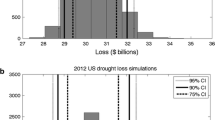Abstract
Policy makers need accurate disaster loss data for decisions about disaster assistance, policy evaluation, and scientific research priorities. But loss estimation is difficult in a disaster situation, and initial loss estimates are seldom evaluated in comparison with actual costs. This paper uses the example of historical flood damage data in the U.S. to evaluate disaster loss data. It evaluates the accuracy of historical flood damage estimates from two federal agencies. The U.S. National Weather Service (NWS) has compiled annual flood loss estimates for each state since 1955. Comparison of the NWS data with similar estimates from five state emergency management agencies reveals substantial disagreement between estimates from different sources. The Federal Emergency Management Agency (FEMA) began in the 1990s to systematically collect damage estimates and cost data associated with its disaster assistance programs. Comparison of early damage estimates with actual expenditures in a California flood disaster reveals large errors in some estimates for individual counties, but no statistically significant tendency to underestimate or overestimate. Positive and negative errors tend to average out and the total damage estimate for the state approximates the final expenditures. Both comparisons indicate that damage estimates for small events or local jurisdictions often are extremely inaccurate. On the other hand, estimates aggregated over large areas or long time periods appear to be reasonably reliable; that is, this study finds that independent estimates for events with losses greater than $500 million disagree by less than 40. The paper suggests ways of interpreting and using such loss estimates to reduce the likelihood of misinterpretation.
Similar content being viewed by others
References
S. D. Changnon (1996) The Great Flood of 1993: Causes, Impacts, and Responsibilities Westview Press Boulder,CO
S. D. Changnon (2003) ArticleTitleMeasures of economic impacts of weather extremes: Getting better but far from what is needed – A call for action Bull. AMS 84 IssueID9 1231–1235
M. W. Downton R. A. Pielke SuffixJr. (2005) ArticleTitleDiscretion without accountability: Politics, flood damage and climate Nat. Hazards Rev. 2 IssueID4 157–166
M. W. Downton J. Z. B. Miller R. A. Pielke SuffixJr. (2005) ArticleTitleA reanalysis of the U.S. National Weather Service flood loss database Nat. Hazards Rev. 6 13–22
InstitutionalAuthorNameFEMA (Federal Emergency Management Agency) (1993) Interagency Hazard Mitigation Team Report: Wisconsin FEMA-994-DR-WI, Interagency Hazard Mitigation Team Madison, WI
FEMA: 1998, Federal Emergency Management Agency Public Assistance Program: Efficient, Effective, Consistent, Program Description. http://www.fema.gov/rrr/pa/padescp.shtm. [Accessed 1/28/04.]
P. Guimaraes F. Hefner D. Woodward (1993) ArticleTitleWealth and income effects of natural disasters: An econometric analysis of hurricane Hugo Rev. Reg. Stud. 2 97–114
InstitutionalAuthorNameHeinz Center: (2000) The Hidden Costs of Coastal Hazards: Implications for Risk Assessment and Mitigation Island Press Washington, DC
Malnic, E.: 1997, El Niño to bring long, wet winter, top forecaster says, Los Angeles Times, 10/15/1997, p. A-1.
Malnic, E.: 1998, Skepticism on El Niño washed away, Los Angeles Times, 2/25/1998, p. A-3.
InstitutionalAuthorNameMcLaughlin Water Engineers, Ltd. (1998) Statewide River Rehabilitation and Floodplain Management Needs Inventory Colorado Water Conservation Board Denver, CO
C. Meade M. Abbott (2003) Assessing Federal Research and Development for Hazard Loss Reduction RAND Santa Monica, CA
Michigan Department of State Police: 1999, Riverine and Great Lakes flooding. Michigan Hazard Analysis, Emergency Management Division, Michigan Department of State Police.
V. Montane (1999) Governor’s Office of Emergency Services, Origins and Development: A Chronology, 1917–1999 Governor’s Office of Emergency Services Rancho Cordova, CA
InstitutionalAuthorNameNRC (National Research Council): (1999) The Impacts of Natural Disasters: A Framework for Loss Estimation National Academy Press Washington, DC
NWS (National Weather Service): 1950–1977 passim, Climatological Data National Summary, Asheville, NC (Years 1975, 1977).
NWS: 2004, Flood Losses: Compilation of Flood Loss Statistics, http://nws.noaa.gov/oh/hic/flood_stats/Flood_loss_time_series.shtml. [Accessed 1/6/04.]
R. A. Pielke SuffixJr. (2000) Policy responses to El Niño, 1997–1998: Implications for forecast value and the future of climate services S. A. Changnon (Eds) El Niño, 1997–1998: The Climate Event of the Century Oxford University Press New York 172–196
R. A. Pielke SuffixJr. M. W. Downton (2000) ArticleTitlePrecipitation and damaging floods: Trends in the United States, 1932–1997 J. Climate 13 3625–3637
R. A. Pielke SuffixJr. R. A. Pielke SuffixSr. (1997) Hurricanes: Their Nature and Impacts on Society Wiley London
Pielke, R. A. Jr., Downton, M. W. and Miller, J. Z. B.: 2002, Flood Damage in the United States, 1926–2000: A Reanalysis of National Weather Service Estimates, National Center for Atmospheric Research, Boulder, CO (http://www.flooddamagedata.org/full_report.html).
InstitutionalAuthorNameUSACE (U.S. Army Corps of Engineers) (1983–2001) passim, Army Corps of Engineers Annual Flood Damage Report to Congress U.S. Government Printing Office Washington, DC
InstitutionalAuthorNameWisconsin Department of Natural Resources (1993) The Floods of 1993: The Wisconsin Experience, Bureau of Water Regulation and Zoning Wisconsin Department of Natural Resources Madison, WI
Author information
Authors and Affiliations
Additional information
The National Center for Atmospheric Research is sponsored by the National Science Foundation.
Rights and permissions
About this article
Cite this article
DOWNTON, M.W., PIELKE, R.A. How Accurate are Disaster Loss Data? The Case of U.S. Flood Damage. Nat Hazards 35, 211–228 (2005). https://doi.org/10.1007/s11069-004-4808-4
Received:
Accepted:
Issue Date:
DOI: https://doi.org/10.1007/s11069-004-4808-4




